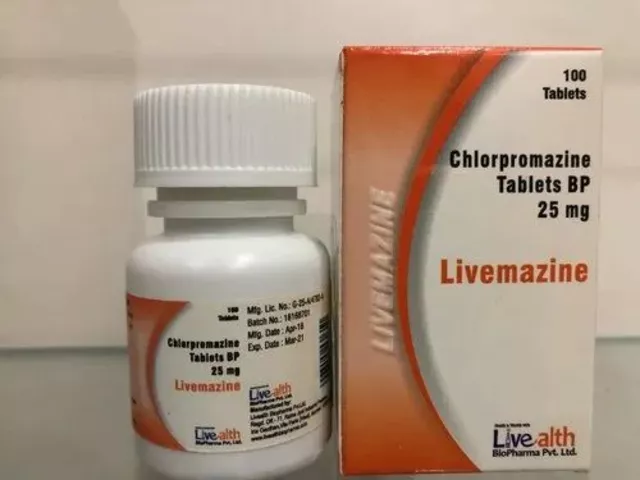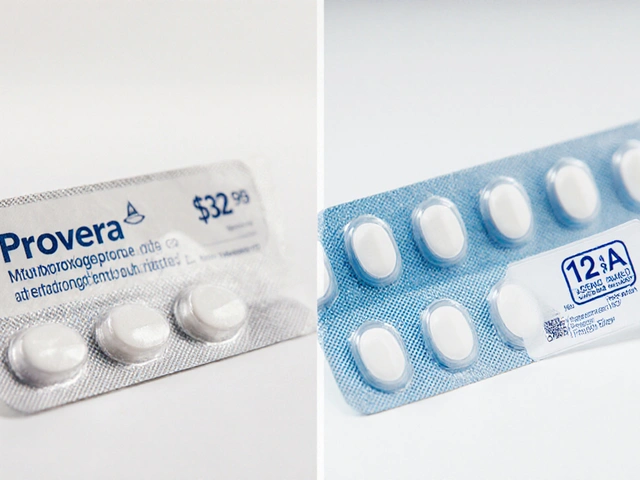Treatment Selection Tool
Select Your Condition
Medical Considerations
Practical Factors
When you or a loved one is facing opioid or alcohol dependence, the first question is often "which medication works best?" Naltrexone has become a popular option, but it isn’t the only game‑changer on the shelf. This guide walks through what Naltrexone Hydrochloride actually does, then lines it up against the most common alternatives - so you can see where each one shines and where it falls short.
Quick Takeaways
- Naltrexone Hydrochloride blocks opioid receptors and reduces alcohol cravings.
- Acamprosate works by stabilizing brain chemistry after alcohol withdrawal.
- Disulfiram creates an aversive reaction when alcohol is consumed.
- Buprenorphine and methadone are agonist therapies for opioid use disorder, while Naltrexone is an antagonist.
- Cost, side‑effect profile, and patient motivation are the biggest factors in choosing a drug.
What Is Naltrexone Hydrochloride?
Naltrexone Hydrochloride is an opioid antagonist approved for the treatment of opioid use disorder (OUD) and alcohol use disorder (AUD). It binds tightly to mu‑opioid receptors, preventing other opioids from producing euphoria or pain relief. For AUD, it dampens the reward pathway that drives drinking urges.
Typical dosing is 50 mg once daily in tablet form for both OUD and AUD. In some settings, a 380 mg injectable depot (once‑monthly) or an implant that releases drug over 3-6 months is used for patients who struggle with daily pills.
Key pharmacology points:
- Onset of action: 1‑2 hours.
- Half‑life: ~4 hours (oral), ~13 days (injectable).
- Metabolised in the liver, excreted via kidneys.
Why People Choose Naltrexone
Patients often favor Naltrexone because it doesn’t produce a “high” and has a relatively clean side‑effect slate compared with opioid agonists. It also works for both OUD and AUD, so clinicians can keep a single medication on hand for patients with dual diagnoses.
Typical side effects include nausea, headache, dizziness, and occasional liver enzyme elevations. Because it blocks opioids, you must be opioid‑free for at least 7‑10 days before starting - otherwise you risk precipitated withdrawal.

Alternative Medications at a Glance
Below is a snapshot of the most frequently prescribed alternatives, grouped by the disorder they target.
| Medication | Primary Indication | Mechanism | Typical Dose | Effectiveness (relapse reduction) | Common Side Effects | Contra‑indications |
|---|---|---|---|---|---|---|
| Naltrexone Hydrochloride | OUD & AUD | Opioid receptor antagonist | 50 mg PO daily | 30‑40 % reduction in relapse (AUD); 20‑30 % in OUD | Nausea, headache, liver enzyme rise | Active opioid use, acute hepatitis |
| Acamprosate | AUD (post‑detox) | Modulates NMDA & GABA pathways | 666 mg PO three times daily | ≈20 % reduction in relapse | Diarrhoea, abdominal pain | Severe renal impairment |
| Disulfiram | AUD (abstinence support) | Inhibits aldehyde dehydrogenase → acetaldehyde buildup | 250 mg PO daily | Highly effective when adherence is 100 % | Flushing, hypotension, hepatotoxicity | Cardiovascular disease, severe liver disease |
| Buprenorphine | OUD (maintenance) | Partial mu‑opioid agonist | 8‑24 mg PO daily (or sub‑lingual) | ≈50‑60 % reduction in illicit opioid use | Constipation, sedation, respiratory depression (high dose) | Severe respiratory disease, acute intoxication |
| Methadone | OUD (maintenance) | Full mu‑opioid agonist | 20‑120 mg PO daily | ≈60‑70 % reduction in opioid use | QT prolongation, constipation, sweating | Long QT syndrome, severe cardiac disease |
Deep Dive Into Each Alternative
Acamprosate
Acamprosate (Campral) is the go‑to for people who have already detoxed from alcohol and want to stay sober. It works by restoring the balance between excitatory (glutamate) and inhibitory (GABA) neurotransmission that chronic drinking disrupts.
Because it’s excreted unchanged by the kidneys, dose adjustment is needed for anyone with a creatinine clearance below 30 mL/min. The drug is safe for the liver, making it a good choice for patients with mild‑to‑moderate liver disease who can’t take Naltrexone.
Disulfiram
Disulfiram (Antabuse) is the classic “aversion” therapy. When you drink while on Disulfiram, you get an intense flushing, nausea, and rapid heart rate - the kind of experience that deters future drinking.
The catch? It only works if you actually take the pill every day. Non‑adherence means no deterrent, and the drug can be dangerous for people with heart disease or liver problems.
Buprenorphine
Buprenorphine (Suboxone, Sublocade) is a partial opioid agonist, meaning it activates the mu‑receptor just enough to ease cravings and withdrawal, but not enough to cause euphoria. Its ceiling effect also makes overdose less likely than full agonists.
It’s taken sub‑lingually or as a monthly implant, offering flexibility for patients who can’t commit to daily dosing. However, it must be started after the patient is in mild withdrawal to avoid precipitated withdrawal.
Methadone
Methadone is the heavyweight of OUD treatment. It’s a full mu‑agonist with a long half‑life, allowing once‑daily dosing under strict clinic supervision. The downside is the risk of cardiac arrhythmias and a higher overdose potential if misused.
Methadone programs often require daily observed dosing, which can be a logistical challenge for people in rural areas.
Naltrexone Implants & Injectable Depot
For patients who forget or resist daily pills, a 3‑month depot injection (Vivitrol) or a surgically placed implant can keep drug levels steady. The cost is higher, but the adherence benefit can outweigh the price for high‑risk individuals.
How to Choose the Right Medication
Choosing isn’t just about which drug “works better" on paper - it’s about matching the therapy to a person’s medical history, lifestyle, and goals. Here’s a quick decision flow:
- Is the primary problem opioid dependence, alcohol dependence, or both? If both, Naltrexone covers both worlds.
- Check liver function. If transaminases are >3× upper limit, avoid Naltrexone and consider Acamprosate or Disulfiram for AUD.
- Assess cardiac health. For patients with QT prolongation, steer clear of Methadone.
- Consider adherence: Daily pill‑taking vs. monthly injection vs. clinic‑observed dosing.
- Factor in cost and insurance coverage - many plans cover generic Naltrexone and Methadone but not the depot injection.
In practice, clinicians often start with the least invasive option (oral Naltrexone) and switch if side effects or relapse rates become problematic.

Potential Pitfalls and How to Avoid Them
- Pre‑treatment opioid withdrawal: Starting Naltrexone too early can trigger severe withdrawal. Use a withdrawal scale (e.g., COWS) and wait at least 7 days.
- Alcohol-Disulfiram interaction: Make sure the patient understands the aversive reaction; otherwise they may stop the medication.
- Renal dosing of Acamprosate: Adjust the dose for eGFR <30 mL/min; otherwise toxic levels can accumulate.
- Buprenorphine induction: Begin when the patient is in mild withdrawal (COWS 5‑12) to avoid precipitated withdrawal.
- Methadone cardiac monitoring: Baseline ECG and periodic QT checks are essential.
Real‑World Example: Jane’s Journey
Jane, a 38‑year‑old accountant from Adelaide, stopped drinking after a health scare and also used heroin intermittently. Her doctor first tried oral Naltrexone 50 mg daily because it would target both her alcohol cravings and opioid use. After two weeks, Jane reported nausea and a rise in liver enzymes, so the doctor switched her to an injectable depot, which eliminated the daily pill burden and reduced her nausea.
For her occasional opioid cravings, the doctor added a low‑dose buprenorphine patch to smooth out any residual urges. After three months, Jane reported zero drinking days and stable opioid use, illustrating how a combined approach can work when tailored to the individual.
Bottom Line
There’s no one‑size‑fits‑all answer. Naltrexone Hydrochloride offers the unique advantage of treating both OUD and AUD with a relatively mild side‑effect profile, making it a first‑line choice for many. Alternatives like Acamprosate or Disulfiram shine when liver health is a concern or when an aversive strategy fits the patient’s motivation. For opioid dependence alone, agonist therapies such as Buprenorphine or Methadone still dominate the evidence base.
Ultimately, the best medication is the one the patient will actually take, under the safest conditions, and that aligns with their personal recovery goals.
Can Naltrexone be used for both alcohol and opioid dependence at the same time?
Yes. Naltrexone blocks opioid receptors, preventing opioid euphoria, while also dampening the brain’s reward response to alcohol. It’s one of the few medications approved for both conditions.
How long should I wait after my last opioid dose before starting Naltrexone?
A minimum of 7‑10 days of opioid abstinence is recommended to avoid precipitated withdrawal. Use a withdrawal rating scale to confirm you’re past the acute phase.
Is Acamprosate safe for people with mild liver disease?
Acamprosate is primarily eliminated unchanged by the kidneys, so it’s considered safe for patients with mild‑to‑moderate liver impairment. Adjust the dose only if renal function is reduced.
What are the main side effects of Disulfiram?
When alcohol is consumed, Disulfiram causes flushing, headache, nausea, vomiting, and rapid heartbeat. Even without alcohol, it can cause liver enzyme elevations and rare neuropathy.
Which medication has the highest adherence rates?
Long‑acting formulations like the Naltrexone depot injection or buprenorphine implants show the best adherence because patients don’t need daily pills.






Post A Comment